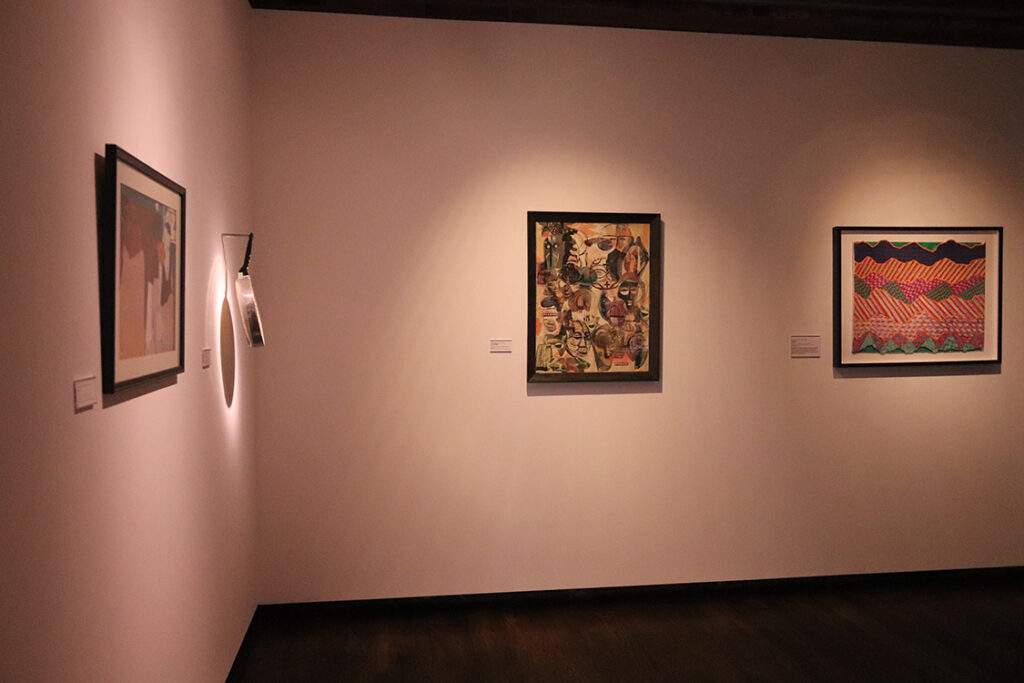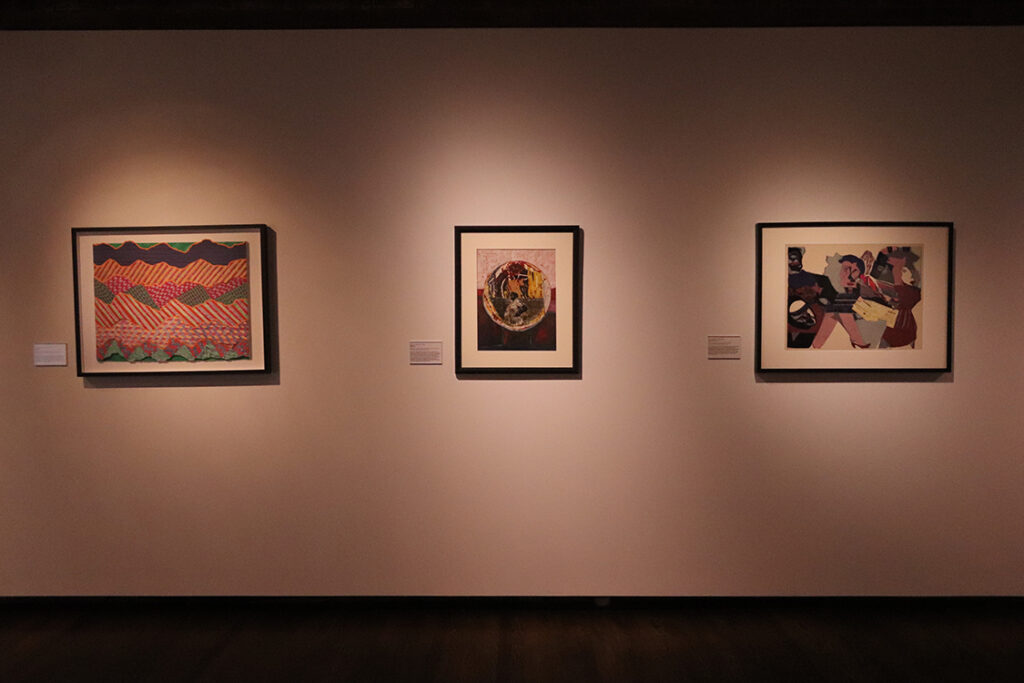









9.
Amalia K. Amaki (b. 1949)
Sisters
1982
Collage of torn and cut paper, and cyanotype
Museums Collections, Gift of Paul R. Jones
10.
Frank D. Robinson Jr. (dates unknown)
Untitled Skillet
2003
Skillet, lacquer, beads, pull tabs, key, and embroidery liquid
Museums Collections, Gift of Paul R. Jones
11.
Amalia K. Amaki (b. 1949)
Candy Box II
2001
Wooden box, photograph, buttons, plastic, beads, and lamé
Museums Collections, Gift of Paul R. Jones
Amalia Amaki finds inspiration in the history and experiences of Black Americans and in everyday objects she collects, such as photographs, beads, and buttons. Her richly adorned heart-shaped candy box features a found photograph of young girls dressed for a religious ritual in white dresses and veils. The open box holds an array of “chocolates” that appear tempting but are actually made from buttons. Amaki’s mixed media works playfully engage with issues of American history and identity.
12.
Evelyn Mitchell (b. 1926)
Art Afrique
1970
Collage of cut printed paper and tissue paper
Museums Collections, Gift of Paul R. Jones
13.
Nannette Acker Clark (b. 1948)
Untitled
1992
Offset lithograph construction with gouache
Museums Collections, Gift of the Brandywine Workshop, Philadelphia, PA
Philadelphia-based sculptor Nannette Acker Clark employs patterns and bold color to convey her interpretations of spiritual journeys. In this composition, an abstract landscape emerges from the overlapping layers of vibrantly colored strips of printed paper. The jagged edges of the paper sections and array of patterned designs give the work a sculptural presence.
14.
David Driskell (1931 – 2020)
Worker
1972
Collage of woodcuts and cut printed paper with oil and gouache
Museums Collections, Gift of Paul R. Jones
The work of David Driskell is characterized by an experimental approach to materials and techniques. In his painted collage Worker, a photograph of a pregnant woman in a cotton field is embedded within a composition of bold color and pattern. Although this figure is central to the work and its message, Driskell revealed in a 2011 interview that he only added the image, a cutout from Look magazine, months after he completed the initial painting. For Driskell, part of the appeal of collage was the inherently adaptable practice of assembling and layering elements.
15.
Michael Ellison (1952 – 2001)
Café des Amis
1985
Color subtractive block print, credit card receipt
Museums Collections, Gift of Paul R. Jones
With its bold colors and rich surface texture, this block print captures the sensory experience of a busy cafe. Michael Ellison’s lively representations of Atlanta often focus on the camaraderie of crowds in social settings. For Ellison, “The bar is sort of like a modern icon. It’s similar to a house of worship for some folks.” He inserts himself directly into the scene of cafe patrons through the collage process, adhering several pieces of a signed credit card receipt onto the surface of the print.
16.
Mary Lovelace O’Neal (b. 1942)
Prophet With No Tongue
1988
Collage of offset lithograph and serigraph
Museums Collections, Gift of Paul R. Jones
Energy pulsates amid the brightly inked strips of layered paper in Mary Lovelace O’Neal’s Prophet With No Tongue. A professor emerita at University of California-Berkeley’s Art Studio, O’Neal gained renown as an educator and social activist as well as an artist. In the 1980s, she began experimenting with printmaking and quickly challenged traditions of form by deconstructing and transforming her prints.
17.
Chakaia Booker (b. 1953)
Untitled
2014
Woodcut, lithograph, and chine collé
Museums Collections, Purchase courtesy of Norine & George Watson
Chakaia Booker is best known for her large-scale sculptures made from discarded tires that are cut up, twisted, and reassembled into new forms. She explores similar ideas of reconstruction and transformation in her prints through the process of collage. Using chine collé—a technique in which an image is transferred to a lightweight paper and simultaneously bonded to a heavier paper during printing—Booker constructs her layered image like a sculpture. In this collage, twisted nails appear to pierce through an abstract design, binding the work together.
18.
Sam Gilliam (b. 1933)
Untitled (Philadelphia)
1987
Serigraph construction with acrylic paint
Museums Collections, Gift of the Brandywine Workshop, Philadelphia, PA
Constructed of interwoven strips of printed paper covered with acrylic paint, Untitled (Philadelphia) exemplifies Sam Gilliam’s enduring interest in texture and form. He made this work at the Brandywine Workshop, a studio founded in 1972 to support racial and cultural diversity in printmaking. Gilliam experimented by cutting up and reassembling prints he pulled from the presses. Deviating from the traditional rectangular format, his prints often have sculptural qualities.
19.
Gary Bellamy (b. 1969)
My Cousin
n.d.
Collage of cut paper
Museums Collections, Gift of Paul R. Jones
20.
Gary Bellamy (b. 1969)
Arrested Development
c. 1993
Collage of newsprint and torn paper
Museums Collections, Gift of Paul R. Jones
In his paper collages, Gary Bellamy engages with issues of social justice and incarceration in the United States. His Arrested Development depicts a Black man grasping the bars of a jail cell, against a background of newspaper clippings from The Washington Post. The clippings—including an obituary of a law enforcement adviser and articles on local and international criminal activity—are overpowered by the humanity imbued in the figure of the incarcerated man, whose body is composed of a fragmented assembly of torn pieces of paper.
21.
Kevin Cole (b. 1960)
Dreams Over Memories (Tie Series)
1992
Offset lithograph, buttons, and wood
Museums Collections, Gift of the Brandywine Workshop, Philadelphia, PA
Dreams over Memories is part of a series of mixed media works by Kevin Cole that utilize the motif of the necktie. Inspired by conversations with his grandfather, Cole employs the looping form to represent power and to symbolize the African American men who were attacked and murdered by lynching while attempting to vote. Cole explained, “While it is rooted in a place of targeted tragedy, the energy that drives its curvilinear twists, knots and loops is the energy found in the souls of ALL those who toil triumph every day against the odds and against the unheralded tragedies of life.”
22.
Benny Andrews (1930 – 2006)
Death
1985
Offset lithograph and collage
Museums Collections, Gift of Paul R. Jones
An artist, activist, and educator, Benny Andrews often addressed themes of suffering and injustice in his work. Andrews helped found the Black Emergency Cultural Coalition, which agitated for greater representation of Black artists and curators in New York art museums in the late 1960s and 1970s. In Sorrow and Death, Andrews combines the lithographic process with his distinctive method of collage to explore grief and militarism. His playful use of color and pattern are often at odds with his somber or menacing subjects, as with the depiction of the armed figure on horseback in Death.
23.
Benny Andrews (1930 – 2006)
Sorrow
1994
Offset lithograph and collage
Museums Collections, Gift of Paul R. Jones
24.
Alonzo Joseph Davis (b. 1942)
Brandywine Bamboo
2001
Offset lithograph and serigraph with reed and silicone
Museums Collections, Gift of the Brandywine Workshop, Philadelphia, PA
The interplay of color is paramount in the lively work of Alonzo Davis. In Brandywine Bamboo, a field of squares composed of diagonal lines in bright hues creates a patchwork effect. Inspired by his travels and reverence for nature, Davis developed an affinity for bamboo as a motif and material for his artistic practice. Along with the slender stalk of bamboo affixed to the paper, this work includes a drawing of a bamboo plant, with its leaves stretched upwards, nearly hidden within the dense network of color ink.
25.
Kaylynn Sullivan TwoTrees (b. 1945)
Maka Wicasa
1992
Lithograph with feathers, dried grasses, and leather
Museums Collections, Gift of the Brandywine Workshop, Philadelphia, PA

